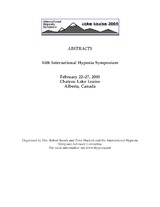Mostrar el registro sencillo del ítem
Aymara children are protected from high-altitude-induced pulmonary hypertension
| dc.contributor.author | Stuber, Thomas | |
| dc.contributor.author | Sartori, Claudio | |
| dc.contributor.author | Hutter, Damian | |
| dc.contributor.author | Salinas Salmón, Carlos E | |
| dc.contributor.author | Thalmann, Sebastien | |
| dc.contributor.author | Turini, Pierre | |
| dc.contributor.author | Jayet, Pierre-Yves | |
| dc.contributor.author | Villena, Mercedes | |
| dc.contributor.author | Scherrer, Urs | |
| dc.contributor.author | Allemann, Yves | |
| dc.date.accessioned | 2017-02-23T18:08:28Z | |
| dc.date.available | 2017-02-23T18:08:28Z | |
| dc.date.issued | 2005-02-22 | |
| dc.identifier.uri | http://repositorio.umsa.bo/xmlui/handle/123456789/9764 | |
| dc.description.abstract | Pulmonary hypertension is a hallmark of the adaptation to ambient lack of oxygen. This assumption is also thought to hold true for high-altitude native children, since invasive studies showed elevated pulmonary-artery pressure in a few children studied at high altitude. However, the data to support this assumption is extremely sparse. We, therefore measured systolic pulmonaryartery pressure (Doppler-echocardiography) and arterial oxygen saturation in 36 Bolivian high-altitude native children of Aymara ethnicity (age 6 months to 13 years, mean SD 7.3 3.0 years) in La Paz (3600 m). We also studied 18 age- and sex-matched Caucasian children who were born or long-term residents of La Paz, and a group of healthy Caucasian children born and living in Berne, Switzerland (450 m). The major new finding was that systolic pulmonary-artery pressure in healthy Bolivian children of Aymara ethnicity was markedly lower than in children of Caucasian descent (25.1 4.1 vs 34.2 9.0 mmHg, P 0.001), and, indeed, was similar to the one measured in children at low altitude (450 m). At high altitude, the lower pulmonary-artery pressure in the Aymara children was not related to better arterial oxygenation, because arterial oxygen saturation was lower than the one measured in the Caucasian children (88.2 4.1 vs. 92.9 2.4%, P 0.0001). These data represent the first measurements of pulmonary-artery pressure in a large group of healthy children living at high-altitude. We found that at high altitude, despite lower arterial oxygen saturation, Aymara children had roughly 30% lower pulmonary artery pressure than well adapted Caucasian children, a value that was comparable to the normal values measured at low altitude. The data challenge the long held concept that high-altitude exposure in children invariably leads to pulmonary hypertension. Protection from hypoxia-induced pulmonary hypertension may represent a specific high-altitude adaptation of the Aymaran ethnicity. | es_ES |
| dc.language.iso | en | es_ES |
| dc.publisher | High Altitude Medicine & Biology | es_ES |
| dc.subject | HIPERTENSIÓN PULMONAR | es_ES |
| dc.subject | GRAN ALTURA | es_ES |
| dc.subject | NIÑOS AYMARAS | es_ES |
| dc.title | Aymara children are protected from high-altitude-induced pulmonary hypertension | es_ES |
| dc.type | Article | es_ES |

